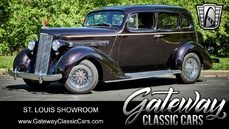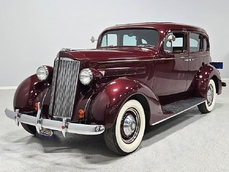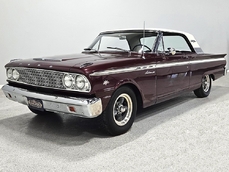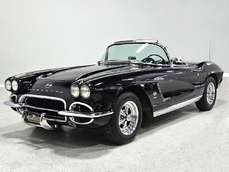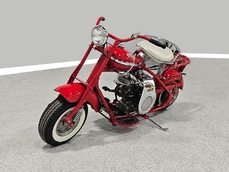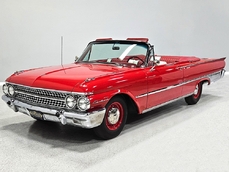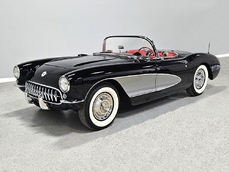Packard 115 502 cubic inch V8 1937
General description :
Building hot rods is an art, and where better to start than with a piece of art itself? At least that’s the idea behind this lovely 1937 Packard 115C convertible coupe. I know that purists will take umbrage with this particular build, and I understand that perspective quite well, but there are some reasons why this car deserves special attention: One, it’s a 115, a six-cylinder, so it’s not like a rare, senior car was taken out of circulation. Two, it’s just beautifully built with all the original details intact—nobody was thinking he could do better than the original Packard stylists. And three, well, it is just a joy to drive. Fully sorted with a 502 cubic inch big block and loaded with all the comfort and convenience features you can imagine (this car has to set some kind of record for density), it’s everything a Packard should be but turned up to 11.
Built about five years ago, this incredible Packard is one of the most comprehensive builds we’ve ever seen. There’s certainly a very high bar to meet when you start with something like a Packard—you just can’t phone it in with a cheap 350 out of a junk yard. Everywhere you look there’s exquisite attention to detail and incredible workmanship and even if you’re not an expert, you’ll quickly see that this was an extraordinarily expensive project. The soft Sherman Blue paint is very handsome, offering just a hint of metallic and a deep shine that only comes from a great deal of time and effort. Aside from the door, rumble seat, and trunk handles, nothing was chopped, shaved, deleted, or modified, so it still looks every bit the Packard that it is only maybe just a little cleaner. Gaps are excellent throughout, so you know there was a lot of attention paid to details when it was going back together and if we had to guess, we’d say that the original base stock was probably pretty darned good. The headlights carry crystal clear lenses and tri-bar bulbs that give it a sophisticated look and the bold and magenta pinstripes along the beltline highlight one of Packard’s most famous styling cues. There’s also a ‘502’ callout there, just to whisper to onlookers that there’s something special under the hood. Out back, the original taillights have LED inserts and a late-model third brake light was beautifully integrated into the rear deck just below the rear window. Like I said, someone was sweating the details.
There’s still a lot of chrome and all of it was treated to show-quality plating during the build. The vertical grille slats are brilliant, the bumpers are distortion-free, and little things like the hood ornament, window frames, and rumble seat steps are all at least as good as new. The windshield frame may look chopped, but I assure you it is not—that’s just the rakish look of the Packard’s original design. You’ll note that even the side mirrors are beautifully installed, not just screwed into the windshield frame, but mounted on the doors with their own little rubber gaskets and hidden fasteners. Nice! The running boards are correctly restored, there’s an accessory grille guard up front, and a custom fuel door was installed on the rear fender for a very clean look.
Lots of money spent inside, too, with gorgeous tan leather upholstery with suede inserts for contrast. The power bucket seats appear to be from a late-model but they’ve been so heavily reworked that they may as well be one-offs. It’s easy to get comfortable thanks to six-way adjustability and reclining backrests, and there’s a great deal of space in this relatively compact Packard. A custom center console was fabricated just for this car and it includes not just the Lokar shifter (note that it has four forward gears, but we’ll talk about that in a moment), but also the power window switches, a pair of cup holders, and even two A/C vents just to move a little extra air. Above that, you’ll find the digital controls for the computerized Air Ride suspension system that offers three presets (high-medium-low) as well as the ability to individually adjust each corner to suit your needs. There’s also a powerful AM/FM/CD stereo with speakers artfully hidden throughout the interior so you can hear them but you’ll never see them. The original dashboard was reworked and fitted with tan leather inserts and beautiful Classic Instruments gauges with brushed stainless faces, so they look vintage but not too vintage. Check out the original chrome duct ahead of the driver for the defroster, the discreet eyeball vents under the dash, and a full set of courtesy lights that work like they should. A tilt steering column wears a LaCarrera wheel with a tan leather rim that looks right and the original Packard E-brake handle was retained. There’s a lot of storage space behind the front seats, as well as a small parcel shelf that’s handy when the top is up, and if nobody is in the rumble seat, there’s a ton of room for your gear. And if you do have guests, they’ll enjoy a full-sized leather rumble seat. A tan canvas convertible top folds easily and offers a beautiful chrome and oak frame and with a little practice, you’ll find it folds quickly and easily and seals up reasonably well. Power windows zip up and down and even the cowl vent is power actuated! It even includes a modest trunk that’s upholstered to match the interior with a custom Packard “P” embossed on the power-operated lid and a full-sized spare just for emergencies.
You did read that correctly, this small Packard packs a big motor: 502 cubic inches of Chevy V8, to be exact. With 500 horsepower on tap, everything this car does is completely effortless. It was not built to be a drag strip screamer, however, so it has good street manners, starting easily and it idles well once it’s warmed up (it’s a bit fussy when it’s cold). There’s a Cadillac air cleaner on top, painted to match the bodywork, and a big Holley 750 double-pumper underneath, so it’s got great throttle response out on the open road. The hardware is functional and well-finished, showing polished accessories, neat wiring and plumbing, and cool Sanderson exhaust manifolds that look cleaner than bare cast iron but don’t bleed heat and noise like headers. A giant radiator with set of electric fans keep it cool and while the firewall was smoothed, they kept the anti-theft number and original serial tag intact. The polished power brake booster also houses a secret button to open the driver’s door in the event that you lose the key fob (or the battery goes dead) and service access is still quite good.
Underneath, there’s a beefy chassis upgraded with a Fatman Fabrications subframe that includes polished stainless A-arms, air springs, and power rack-and-pinion steering. The transmission is a built 700R4 4-speed automatic with overdrive, which means that even with 3.55 gears in the 9-inch Ford rear end, it’s a superlative highway cruiser. The frame has been heavily reinforced to handle the rigors of the upgraded powertrain and there are zero squeaks or rattles inside, so it must be working. Power front disc brakes add confidence to the solid little convertible and thanks to the Air Ride suspension, ride quality is surprisingly good—it just ignores bumps that upset lesser cars. The exhaust is 100% stainless and much of it was polished to look good, and while it’s definitely got a big V8 rumble, it’s never annoying or too aggressive. You could go crazy trying to figure out the right rolling stock on a car like this, and while everyone else is doing the same old chrome wires, we think the 17-inch American Racing alloys look great, especially with staggered 225/50/17 front and 235/65/17 rear Goodyear Eagle radials.
The attention to detail on this car is extremely impressive, so don’t write it off as just a guy trying to be different by cutting up a Packard. Instead, call this an homage, a tribute that salutes the Packard heritage of quality, performance, reliability, and comfort. It’s beautiful to look at, very well engineered, and a joy to drive fast or slow. The massive amounts of money required to build a car like this can’t be overlooked and the next owner of this Packard will own a car that not only commands respect on the show field, but which will continue to delight him with unusual features and thoughtful touches. It’s a hot rod, yes, but it’s also a car, and that might be the highest complement we can pay it. This Packard is one heck of a car!
http://www.harwoodmotors.com/vehicles/inventory_details.php?id=771
1937 Packard 115 502 cubic inch V8 is listed sold on ClassicDigest in Macedonia by for $79900.
Car Facts
Car type : Car Make : Packard Model : 115 Model Version : 502 cubic inch V8 Engine size : 0.0 Model Year : 1937 Sub type : Convertible Location : Ohio
Sold
Seller Information
Sold
People who viewed this Packard 115 also viewed similar Packard listed at ClassicDigest
Other cars listed for sale by this dealer
About Packard
Packard: A Comprehensive HistoryEarly Years and Foundation:
Founding: The Packard Motor Car Company was established in 1899 in Warren, Ohio, by James Ward Packard, William Doud Packard, and George Lewis Weiss.
Pioneering Luxury: Initially producing high-quality automobiles, Packard became synonymous with luxury, craftsmanship, and engineering excellence.
Notable Achievements and Contributions:
Packard Twin Six: Introduced in 1916, this V12-powered car established Packard as a premier luxury automobile brand.
Model Line Expansion: Packard expanded its lineup with various models, including sedans, coupes, convertibles, and limousines, catering to affluent customers seeking elegance and performance.
Engineering Innovations: The brand introduced several innovations, such as the first use of aluminum pistons, air conditioning, and the Ultramatic automatic transmission.
Ten Historically Significant Models with Technical Specifications:
Packard Twin Six (1916):
Engine: 7.3L V12 engine.
Performance: Around 85 horsepower.
Packard Eight (1930-1938):
Engine: Straight-8 engine with various displacements.
Performance: Ranged from 90 to over 130 horsepower.
Packard Super Eight (1939-1951):
Engine: Straight-8 engine.
Performance: Produced between 130 to 180 horsepower.
Packard One-Twenty (1935-1942):
Engine: Straight-8 engine.
Performance: Approximately 100 to 120 horsepower.
Packard Clipper (1941-1957):
Engine: V8 engine.
Performance: Ranging from 135 to 185 horsepower.
Packard Caribbean (1953-1956):
Engine: V8 engine.
Performance: Varying between 275 to 310 horsepower.
Packard Patrician (1951-1956):
Engine: Inline-8 and V8 engines.
Performance: Ranged from 150 to 180 horsepower.
Packard Hawk (1958):
Engine: V8 engine.
Performance: Produced around 275 horsepower.
Packard Executive (1956-1958):
Engine: V8 engine.
Performance: Varying between 240 to 290 horsepower.
Packard Predictor (1956):
Engine: Concept car showcasing design and technology.
Performance: Prototype model.
Legacy and Influence:
Quality and Elegance: Packard was revered for its exceptional build quality, refined styling, and luxury features, often considered on par with European luxury brands like Mercedes-Benz.
End of Production: The brand faced financial struggles in the 1950s, leading to its merger with Studebaker and eventual discontinuation in the late 1950s, marking the end of an era in American luxury automobiles.
Packard left an enduring legacy in the automotive industry, symbolizing elegance, engineering excellence, and a commitment to luxury that has been admired and respected by car enthusiasts worldwide.



